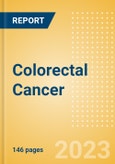These sales forecasts leverage data on pharmaceutical sales and drug availability from the World Markets Healthcare (WMH) and POLI Price Intelligence databases.
CRC, also called osteocolorectal cancer is a rare blood disorder that causes bone marrow (BM) fibrosis. Despite being a rare blood cancer, CRC is a blockbuster market and is expected to grow from sales of $2.39 billion in 2021 to $2.89 billion in 2031 at a compound annual growth rate (CAGR) of 1.9%.
Key Highlights
- Report deliverables include a PowerPoint report and Excel-based forecast model
- Forecasts includes the 8MM
- Forecasts covers from 2021-2031
- The publisher valued the colorectal cancer market in the 8MM at $2.39 billion and expects the market to increase to $2.89 billion by 2031
- Incyte, GSK and CTI BioPharma are expected to take market-leading position in 2031
- A moderate level of unmet need will remain for most colorectal cancer patient populations during the forecast period
- The late-stage pipeline in colorectal cancer is robust and is likely to provide significant clinical benefit to many colorectal cancer patient populations, with fierce competition expected
Despite being a rare blood cancer, CRC is a blockbuster market and is expected to grow from sales of $2.39 billion in 2021 to $2.89 billion in 2031, as shown in Figure 1, at a compound annual growth rate (CAGR) of 1.9%. Peak-year sales are set to be reached in 2027, driven by the approvals of several promising late-stage pipeline agents and the continued clinical dominance of Jakafi/Jakavi (ruxolitinib). In 2028, Jakafi/Jakavi is set to come off-patent in the US, which will greatly decrease its total market sales. However, the loss of total market sales will be somewhat recuperated in 2028 and beyond by the additional growth in market value of other pipeline Janus kinase (JAK) inhibitors and targeted therapies, with sales of these agents being driven by ameliorating critical unmet needs within the CRC treatment paradigm.
Several markets across the 8MM will experience growth driven by common drivers -
- Approvals of late-stage pipeline agents, including novel JAK inhibitors and targeted therapies, which will partially meet critical unmet clinical needs
- Decreased reliance on generic immunomodulatory agents, androgens, and erythropoietin-stimulating agents
- Increased utilization of novel combination regimens with premium-priced agents
Common barriers to market growth experienced across the 8MM primarily include a series of patent expiries:
- Patent expiry of Jakafi/Jakavi
- Patent expiry of Vonjo (pacritinib)
- Patent expiry of Inrebic (fedratinib)
Scope
– Overview of colorectal cancer, including epidemiology, symptoms, diagnosis, and disease management.- Annualized colorectal cancer therapeutics market revenue, cost of therapy per patient, and treatment usage patterns forecast from 2021 to 2031.
- Key topics covered include strategic competitor assessment, market characterization, unmet needs, clinical trial mapping, and implications of these factors for the colorectal cancer therapeutics market.
- Pipeline analysis: comprehensive data assessing emerging trends and mechanisms of action under development for colorectal cancer treatment. The most promising candidates in Phase III and Phase IIb development are profiled.
- Analysis of the current and future market competition in the global colorectal cancer therapeutics market. Insightful review of the key industry drivers, restraints and challenges. Each trend is independently researched to provide qualitative analysis of its implications
Reasons to Buy
– Develop and design your in-licensing and out-licensing strategies through a review of pipeline products and technologies, and by identifying the companies with the most robust pipeline.- Develop business strategies by understanding the trends shaping and driving the global colorectal cancer therapeutics market.
- Drive revenues by understanding the key trends, innovative products and technologies, market segments, and companies likely to impact the global colorectal cancer therapeutics market in the future.
- Formulate effective sales and marketing strategies by understanding the competitive landscape and by analyzing the performance of various competitors.
- Identify emerging players with potentially strong product portfolios and create effective counter-strategies to gain a competitive advantage.
- Organize your sales and marketing efforts by identifying the market categories and segments that present maximum opportunities for consolidations, investments and strategic partnerships
Table of Contents
Companies Mentioned (Partial List)
A selection of companies mentioned in this report includes, but is not limited to:
- Amgen
- Bayer
- Bristol Myers Squibb
- Chia Tai Tianqing Pharmaceutical Group
- Eli Lilly
- Exelixis
- Genentech
- GenFleet Therapeutics
- Gritstone bio
- GSK
- Merck
- Novartis
- Pfizer
- Qilu Pharmaceutical
- Roche
- Sanofi
- Shanghai Henlius Biotech
- SUNHO Biologics
- Takeda Pharmaceuticals
- Tracon Pharmaceuticals








